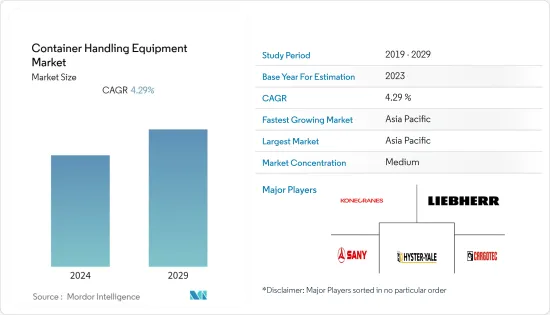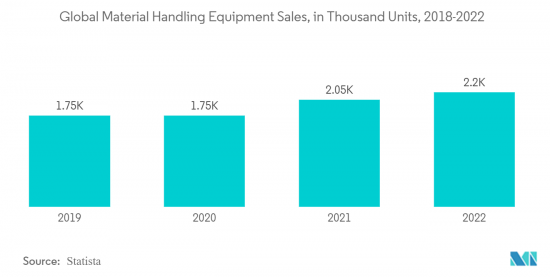 |
市場調査レポート
商品コード
1406130
コンテナ荷役機器 - 市場シェア分析、産業動向と統計、2024年~2029年の成長予測Container Handling Equipment - Market Share Analysis, Industry Trends & Statistics, Growth Forecasts 2024 - 2029 |
||||||
● お客様のご希望に応じて、既存データの加工や未掲載情報(例:国別セグメント)の追加などの対応が可能です。 詳細はお問い合わせください。
| コンテナ荷役機器 - 市場シェア分析、産業動向と統計、2024年~2029年の成長予測 |
|
出版日: 2024年01月04日
発行: Mordor Intelligence
ページ情報: 英文 100 Pages
納期: 2~3営業日
|
- 全表示
- 概要
- 目次
コンテナ荷役機器市場は、現在73億4,000万米ドルと評価されており、今後5年間で94億3,000万米ドルに成長し、予測期間中の収益でCAGR 4.29%を記録すると予測されています。

中期的には、国際商業の拡大と貨物輸送ニーズの高まりが、ここ数十年の世界経済の発展を決定づけた。大規模な輸出入に関わる大規模な製造施設があるため、中国やインドなどのアジア太平洋諸国は、世界化と工業化の結果として最も高い成長率を含むと予測されています。
港湾ターミナルの自動化に向けた動向の変化、eコマース産業の台頭、生産現場での労働への予防措置や厳しい排出規制を重視した電気機器やハイブリッド機器への要求の高まりは、コンテナ荷役機器市場に革新的なビジネスチャンスをもたらしています。
コンテナ荷役機器市場は、港湾ターミナルの自動化、eコマース産業の成長、生産現場での労働者の安全や厳しい排出基準に重点を置いた電気機器やハイブリッド機器への要求の高まりに向けた動向の変化により、革新的な新たなビジネスチャンスを目にする可能性があります。
コンテナ荷役機器市場の動向
コンテナ荷役機器の電動化重視の高まり
世界経済の成長と工業化の進展が、さまざまな分野でのコンテナ・ハンドリング機器の需要を促進しています。建設業、製造業、港湾荷役業など、幅広い用途で使用されていることが、売上増加の要因となっています。
ハンドリング機器の売上を押し上げるもう一つの要因は、特にインド、ブラジル、シンガポール、メキシコなどの新興経済諸国におけるeコマース、小売、物流産業の急速な拡大です。
環境効率は、カーゴとマテリアルハンドリングにとって極めて重要になった。世界中の港湾やターミナルがエネルギー効率の改善と排出量の削減に向けて動き出す中、電動化は業界全体を席巻する最新の動向です。港湾設備の電化は、排出ガスを大幅に削減することが証明されました。各国が排出量削減に注力していることから、電気コンテナやハイブリッド電気コンテナの採用は今後数年で増加すると予想されます。
さらに、一部のeコマース企業は、配送時間を短縮するため、商品の積み込みとピックアップのプロセスをスピードアップする自律型フォークリフトや電動フォークリフトに多額の投資を行うなど、新たな戦略を展開しています。CO2排出を規制するために世界中でディーゼル車に対する厳しい排出規制が実施されているため、メーカーはより環境に優しいフォークリフト・モデルを提供するようになった。さらに、この点に関する政府のイニシアチブは、予測期間にわたって市場の需要を押し上げます。
より厳しい排出規制は、コンテナ荷役機器のメーカーに、その動力能力を犠牲にすることなく製品のエネルギー効率を改善するよう求める可能性があります。環境保護庁(EPA)によるオフロード車両/機器(建設、農業採掘、マテリアルハンドリング機器を含む)の新しい排出基準によると、港湾または複合一貫輸送鉄道ヤードに持ち込まれるすべての新規購入ヤードトラックおよび非ヤードトラック機器は、Tier 4最終オフロードエンジンまたはモデルイヤー(MY)2010またはそれ以降のオンロードエンジンのいずれかを搭載しなければならないです。このように、Tier 4エンジン技術は、メーカーが新しいコンテナ荷役機械に徐々に採用しています。
フォークリフト技術の進歩は、誰にとっても倉庫環境をより安全にします。例えば、フォークリフト事故の可能性を減らすことは、早回りをより簡単にすることで達成できます。労働者が怪我をして職を失うことはなく、生産性は変わりません。さらに、事故率が低下すれば、フォークリフトの修理も少なくて済みます。
以上のような世界の発展により、コンテナハンドリング機器の需要は予測期間中に伸びると思われます。

アジア太平洋地域が市場のリーダーであり続ける
アジア太平洋地域は、中国やインドといった世界の主要新興経済諸国から構成されており、原材料や最終製品への要求が高いため、大量のコンテナが輸出入されています。
中国はアジア太平洋地域の主要国のひとつであり、その経済成長に支えられた産業活動が最も盛んです。中国には34のコンテナ港と2,000の小港があります。上海は4,330万TEUの輸送能力を持つ世界最大の港です。
同国の成長率は高いが、徐々に緩やかな方向に向かっている(人口が高齢化し、経済が投資から消費へ、製造業からサービス業へ、外需から内需へとリバランスするため)。しかし、中国の人件費と材料費が安いため、多くの企業が中国で製品を製造し、その後必要な仕向地に輸出しています。その結果、中国は世界有数の輸出国となった。
中国の港湾建設は近年大きく発展し、貨物量とコンテナ処理量の両方で世界上位10港のうち7港が中国にあります。洋山深水港は上海港の主要港として、コンテナ処理量は少なくとも全体の40%を占める大きな規模を誇っています。第4期の開港により、上海港の年間コンテナ処理量は4,000万TEUを超え、これは米国全港の年間コンテナ処理量の合計に匹敵します。
インドはアジア太平洋地域の主要国のひとつであり、その経済成長に支えられた輸出入活動が行われています。ムンバイ港は国内最大かつ最も忙しい港です。
港湾・海運・水路省によると、インドで最も多忙な国営コンテナゲートウェイであるジャワハルラール・ネルー港湾公社(JNPA)の取扱量は417万7,000TEUで、前年同期の322万2,000TEUから増加しました。
日本には大手荷役機械メーカーが多く、港湾荷役機械の設計・製造は現地企業が独占していました。設計、製造、品質に関しても独自の基準を持っていました。そのため、他国の製品が日本の市場に参入するには多くの労力を要しました。
日本が高齢化と人口減少の問題に直面しているのは、企業が生産性と安全性を向上させるために、ターミナル・コンテナ荷役オートメーションなどの先端技術の開発に投資している理由です。また、コンテナ荷役機器の運用コストを削減するため、古い機器を最新技術で改造する動きも始まっています。Kone CranesとKalmarは、古い機器の改造サービスを提供する多くの企業のうちの2つです。これには古い機器の自動化も含まれます。
地域全体で上記のような開拓が行われており、予測期間中に市場が大きく成長する可能性が高いです。
コンテナ荷役機器産業の概要
Cargotec Corp、Liebherr Group、SANY Group、Hyster-Yale Materials Handling Inc.、Konecranesなど、複数の主要企業がコンテナハンドリング機器市場を独占しています。各社は、新製品や先進製品の革新のための研究開発に多額の投資を行っています。世界各地での製造施設の拡張は、今後数年間で市場を押し上げると予想されています。例えば
- 2023年9月、Global Ports社はVostochnaya Stevedoring Company(VSC)の極東ターミナルに設備を設置しました。同社は上海振華重工(ZPMC)と港湾コンテナ荷役機器を購入する覚書に調印しました。
- 2022年10月、トヨタマテリアルハンドリングは、北米でトヨタの3輪電動フォークリフトの更新版を発売しました。この新型電動フォークリフトは、このセグメントでトップセラーのフォークリフトに新機能と新技術を搭載しました。
- 2022年1月、Cargotecの一部であるKalmarは、ノルウェーで世界初の複合充電システム付き電動リーチスタッカーを供給することでWestport ASと合意しました。この受注には5年間のカルマー・コンプリート・ケア・サービス契約も含まれており、これはカーゴテックの2022年第1四半期の受注に計上され、納品は2022年の第4四半期初頭に予定されています。
その他の特典
- エクセル形式の市場予測(ME)シート
- 3ヶ月間のアナリストサポート
目次
第1章 イントロダクション
- 調査の前提条件
- 調査範囲
第2章 調査手法
第3章 エグゼクティブサマリー
第4章 市場力学
- 市場促進要因
- コンテナ荷役機器の電動化重視の高まり
- 市場抑制要因
- 高い資本コストとコンテナ荷役機器の複雑化
- ポーターのファイブフォース分析
- 供給企業の交渉力
- 買い手/消費者の交渉力
- 新規参入業者の脅威
- 代替品の脅威
- 競争企業間の敵対関係の強さ
第5章 市場セグメンテーション(市場規模)
- 機器タイプ別
- フォークリフト
- スタッキングクレーン
- 移動式港湾クレーン
- ゴムタイヤ式ガントリークレーン
- 推進力タイプ別
- ディーゼル
- 電気式
- ハイブリッド
- 地域別
- 北米
- 米国
- カナダ
- その他の北米
- 欧州
- ドイツ
- 英国
- フランス
- イタリア
- スペイン
- その他の欧州
- アジア太平洋
- インド
- 中国
- 日本
- 韓国
- その他のアジア太平洋
- 世界のその他の地域
- 南米
- 中東・アフリカ
- 北米
第6章 競合情勢
- ベンダー市場シェア
- 企業プロファイル
- Cargotec Corp.
- Liebherr Group
- SANY Group
- Shanghai Zhenhua Heavy Industries Co. Ltd(ZPMC)
- Hyster-Yale Materials Handling Inc.
- Anhui HELI Forklifts Group Co. Ltd
- Hoist Material Handling Inc.
- CVS Ferrari SpA
- Lonking Holdings Limited
- Konecranes
第7章 市場機会と今後の動向

The Container Handling Equipment Market is valued at USD 7.34 billion in the current year and is expected to grow to USD 9.43 billion by the next five years, registering a CAGR of 4.29% in terms of revenue during the forecast period.
Over the medium term, the expansion of international commerce and the rising need for cargo transportation defined global economic development in recent decades. Due to large-scale manufacturing facilities involved in large-scale imports and exports, Asia-Pacific nations such as China and India are predicted to include the highest growth rates as a result of globalization and industrialization.
The shifting trends toward automation of port terminals, the rising e-commerce industry, and growing requirements for electric and hybrid equipment, with emphasis on precaution for labor on the production floor and stringent emission norms, provide innovative business opportunities in the container handling equipment market.
The container handling equipment market may see innovative new opportunities as a result of shifting trends toward port terminal automation, the growing e-commerce industry, and growing demands for electric and hybrid equipment, with an emphasis on worker safety on the production floor and stringent emission standards.
Container Handling Equipment Market Trends
Growing Emphasis on the Electrification of Container Handling Equipment
The growing world economy and rising industrialization are driving the demand for container-handling equipment across different fields. Their use in industries like construction, manufacturing, and port handling, owing to the wide range of applications, are the reasons for their increased sales.
Another factor boosting the handling equipment sales is the rapid expansion of the e-commerce, retail, and logistics industries, especially in developing economies such as India, Brazil, Singapore, and Mexico.
Eco-efficiency became extremely important for cargo and material handling. As ports and terminals around the world move toward improved energy efficiency and reduced emissions, electrification is the latest trend sweeping across the industry. Electrification of port equipment proved to reduce emissions hugely. With countries focusing on reducing their emissions, the adoption of electric and hybrid-electric containers is expected to increase in the years to come.
In addition, some e-commerce companies are developing new strategies, including investing heavily in autonomous and electric forklifts to speed up the loading and picking up processes of products as they reduce the delivery time. Stringent emission norms for diesel vehicles across the globe to regulate CO2 emissions led the manufacturers to offer more environment-friendly forklift truck models. Furthermore, government initiatives in this regard boost demand in the market over the forecast period.
More stringent emission regulations may require manufacturers of container handling equipment to improve the energy efficiency of their products without sacrificing their power capabilities. According to the new emission standards for off-road vehicles/equipment (including construction, agricultural mining, and material handling equipment) by the Environmental Protection Agency (EPA), all newly purchased yard truck and non-yard truck equipment brought onto a port or intermodal rail yard must include either a Tier 4 final off-road engine or a model year (MY) 2010 or newer on-road engine. Thus, Tier 4 engine technology is gradually adopted by manufacturers in their new container handling equipment.
Forklift technology advancements make warehouse environments safer for everyone. For instance, reducing the likelihood of forklift accidents can be achieved by making it simpler to make a fast turn. Workers won't get hurt and lose their jobs, and productivity rates can stay the same. Additionally, fewer forklift repairs are required when accident rates drop.
With the development mentioned above across the globe, the demand for container handling equipment is likely to grow during the forecast period.

Asia-Pacific Remains the Market Leader
The Asia-Pacific region consists of major developing economies of the world, such as China and India, where a large volume of containers is exported and imported due to the high requirement for raw materials and final products.
China is one of the major countries in the Asia-Pacific region, with the highest industrial activities being supported by its growing economy. China includes 34 container ports and 2,000 minor ports. Shanghai is the world's largest port, with a capacity of 43.3 million TEU.
The country's growth rate is high but is gradually moving toward moderate (as the population ages and the economy rebalances from investment to consumption, manufacturing to services, and external to internal demand). However, due to low labor and material costs in China, many companies manufacture their products in China and later export them to required destinations. It helped China position itself as the world's leading exporter.
China's port construction developed so greatly in recent years that seven of the world's top 10 ports, in terms of both cargo and container throughput, are in China. As a major part of Shanghai Port, Yangshan Port boasts of a big container throughput, which accounts for at least 40% of the total. The opening of the fourth phase will help the annual container throughput in Shanghai Port surpass 40 million TEUs, which is equivalent to the sum of all US ports' annual container throughput.
India is one of the major countries in the Asia-Pacific region, with import and export activities being supported by its growing economy. Mumbai Port is the country's largest and busiest port.
According to the Ministry of Ports, Shipping and Waterways, India's busiest state-run container gateway, Jawaharlal Nehru Port Authority (JNPA), handled 4.177 million TEUs, up from 3.222 million TEUs during the same time previous year.
Japan contains many of the leading cargo-handling machinery manufacturers, and the local companies made the monopoly on designing and manufacturing the cargo handling equipment for ports in Japan. They had unique standards for design, manufacturing, and quality. Thus, it took a lot of work for the products of other countries to enter the market of Japan.
Japan is facing the problem of aging and decreasing population, which is the reason why companies are investing in the development of advanced technologies such as terminal container handling automation to improve productivity and safety. They also started to retrofit old equipment with the latest technology to reduce the operational costs of container handling equipment. Kone Cranes and Kalmar are two of many companies that provide retrofitting services for old equipment. It includes old equipment automation as well.
The development mentioned above across the region is likely to witness major growth for the market during the forecast period.
Container Handling Equipment Industry Overview
Several key players, such as Cargotec Corp, Liebherr Group, SANY Group, Hyster-Yale Materials Handling Inc., Konecranes, and others, dominate the container handling equipment market. Companies are investing heavily in research and development for the innovation of new and advanced products. The expansion of manufacturing facilities across the globe is anticipated to boost the market in the coming years. For instance,
- In September 2023, Global Ports equipped the Far Eastern terminal of Vostochnaya Stevedoring Company (VSC). They signed a memorandum of intent with Shanghai Zhenhua Heavy Industry Company (ZPMC) to buy portside container handling equipment.
- In October 2022, Toyota Material Handling launched an updated version of Toyota's 3-Wheel Electric Forklift in North America. The new updated electric forklift equipped with new features and technology to the top-selling forklift in the segment.
- In January 2022, Kalmar, part of Cargotec, agreed with Westport AS to supply the world's first electric reach stacker with a combined charging system in Norway. The order also includes a five-year Kalmar Complete Care service agreement, which was booked in Cargotec's Q1 2022 order intake, with delivery scheduled for early Q4 of 2022.
Additional Benefits:
- The market estimate (ME) sheet in Excel format
- 3 months of analyst support
TABLE OF CONTENTS
1 INTRODUCTION
- 1.1 Study Assumptions
- 1.2 Scope of the Study
2 RESEARCH METHODOLOGY
3 EXECUTIVE SUMMARY
4 MARKET DYNAMICS
- 4.1 Market Drivers
- 4.1.1 Growing Emphasis on The Electrification of Container Handling Equipment
- 4.2 Market Restraints
- 4.2.1 High Capital Cost And Increasing Complexity of Container Handling Equipment
- 4.3 Porter's Five Forces Analysis
- 4.3.1 Bargaining Power of Suppliers
- 4.3.2 Bargaining Power of Buyers/Consumers
- 4.3.3 Threat of New Entrants
- 4.3.4 Threat of Substitute Products
- 4.3.5 Intensity of Competitive Rivalry
5 MARKET SEGMENTATION (Market Size in Value (USD))
- 5.1 By Equipment Type
- 5.1.1 Forklift Truck
- 5.1.2 Stacking Crane
- 5.1.3 Mobile Harbor Crane
- 5.1.4 Rubber-tired Gantry Crane
- 5.2 By Propulsion Type
- 5.2.1 Diesel
- 5.2.2 Electric
- 5.2.3 Hybrid
- 5.3 By Geography
- 5.3.1 North America
- 5.3.1.1 United States
- 5.3.1.2 Canada
- 5.3.1.3 Rest of North America
- 5.3.2 Europe
- 5.3.2.1 Germany
- 5.3.2.2 United Kingdom
- 5.3.2.3 France
- 5.3.2.4 Italy
- 5.3.2.5 Spain
- 5.3.2.6 Rest of Europe
- 5.3.3 Asia-Pacific
- 5.3.3.1 India
- 5.3.3.2 China
- 5.3.3.3 Japan
- 5.3.3.4 South Korea
- 5.3.3.5 Rest of Asia-Pacific
- 5.3.4 Rest of the World
- 5.3.4.1 south America
- 5.3.4.2 Middle-East and Africa
- 5.3.1 North America
6 COMPETITIVE LANDSCAPE
- 6.1 Vendor Market Share
- 6.2 Company Profiles*
- 6.2.1 Cargotec Corp.
- 6.2.2 Liebherr Group
- 6.2.3 SANY Group
- 6.2.4 Shanghai Zhenhua Heavy Industries Co. Ltd (ZPMC)
- 6.2.5 Hyster-Yale Materials Handling Inc.
- 6.2.6 Anhui HELI Forklifts Group Co. Ltd
- 6.2.7 Hoist Material Handling Inc.
- 6.2.8 CVS Ferrari SpA
- 6.2.9 Lonking Holdings Limited
- 6.2.10 Konecranes
